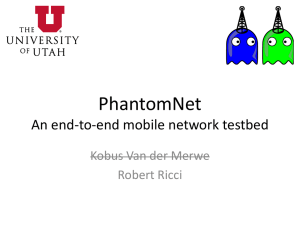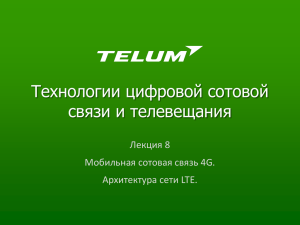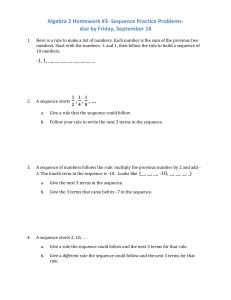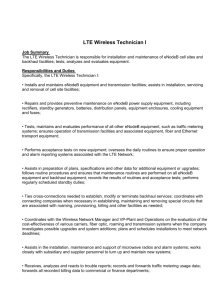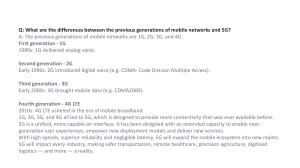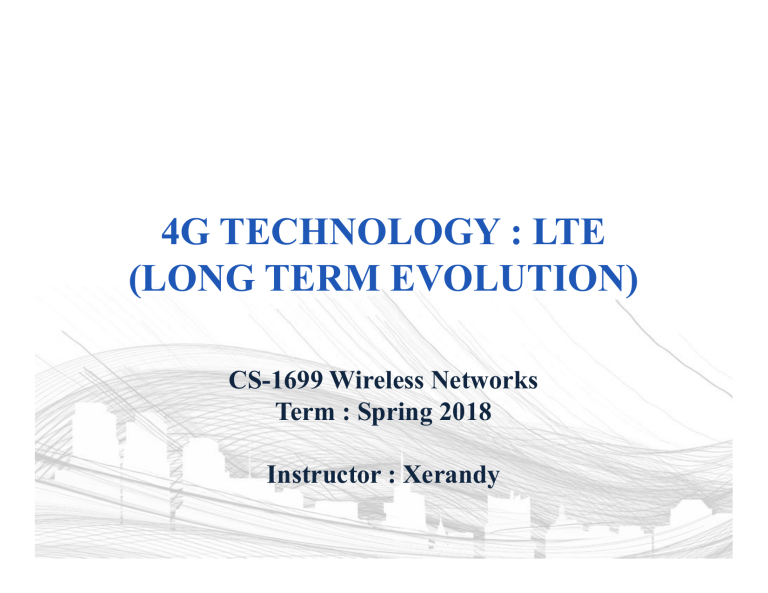
4G TECHNOLOGY : LTE (LONG TERM EVOLUTION) CS-1699 Wireless Networks Term : Spring 2018 Instructor : Xerandy PURPOSE, MOTIVATION, AND APPROACH TO 4G • Ultra-mobile broadband access – For a variety of mobile devices • International Telecommunication Union (ITU) 4G directives for IMT-Advanced – All-IP packet switched network. – Peak data rates • Up to 100 Mbps for high-mobility mobile access • Up to 1 Gbps for low-mobility access – Dynamically share and use network resources – Smooth handovers across heterogeneous networks, including 2G and 3G networks, small cells such as picocells, femtocells, and relays, and WLANs – High quality of service for multimedia applications Fourth Generation Systems and Long Term Evolution 14-2 PURPOSE, MOTIVATION, AND APPROACH TO 4G • No support for circuit-switched voice – Instead providing Voice over LTE (VoLTE) • Replace spread spectrum with OFDM Fourth Generation Systems and Long Term Evolution 14-3 4G TECHNOLOGY • Two candidates for 4G – IEEE 802.16 WiMax (described in Chapter 16) • Enhancement of previous fixed wireless standard for mobility – Long Term Evolution • Third Generation Partnership Project (3GPP) • Consortium of Asian, European, and North American telecommunications standards organizations • Both are similar in use of OFDM and OFDMA • LTE has become the universal standard for 4G – All major carriers in the United States Fourth Generation Systems and Long Term Evolution 14-4 14.1 THIRD VS. FOURTH GENERATION CELLULAR NETWORKS Fourth Generation Systems and Long Term Evolution 14-5 LTE ARCHITECTURE • Some features started in the 3G era for 3GPP • Initial LTE data rates were similar to 3G • 3GPP Release 8 – Clean slate approach – Completely new air interface • OFDM, OFDMA, MIMO • 3GPP Release 10 – Known as LTE-Advanced – Further enhanced by Releases 11 and 12 Fourth Generation Systems and Long Term Evolution 14-6 Fourth Generation Systems and Long Term Evolution 14-7 S11 S6a S5/S8 14.2 OVERVIEW OF THE EPC/LTE ARCHITECTURE Fourth Generation Systems and Long Term Evolution 14-8 EVOLVED PACKET SYSTEM • Overall architecture is called the Evolved Packet System (EPS) • 3GPP standards divide the network into – Radio access network (RAN) – Core network (CN) • Each evolve independently. • Long Term Evolution (LTE) is the RAN – Called Evolved UMTS Terrestrial Radio Access (E-UTRA) – Enhancement of 3GPP’s 3G RAN • Called the Evolved UMTS Terrestrial Radio Access Network (EUTRAN) – eNodeB is the only logical node in the E-UTRAN – No RNC Fourth Generation Systems and Long Term Evolution 14-9 EVOLVED PACKET SYSTEM • Evolved Packet Core (EPC) – Operator or carrier core network – It is important to understand the EPC to know the full functionality of the architecture • Some of the design principles of the EPS – Clean slate design – Packet-switched transport for traffic belonging to all QoS classes including conversational, streaming, real-time, non-real-time, and background – Radio resource management for the following: end-to-end QoS, transport for higher layers, load sharing/balancing, policy management/enforcement across different radio access technologies – Integration with existing 3GPP 2G and 3G networks – Scalable bandwidth from 1.4 MHz to 20 MHz – Carrier aggregation for overall bandwidths up to 100 MHz Fourth Generation Systems and Long Term Evolution 14-10 FUNCTIONS OF THE EPS • Network access control, including network selection, authentication, authorization, admission control, policy and charging enforcement, and lawful interception • Packet routing and transfer • Security, including ciphering, integrity protection, and network interface physical link protection • Mobility management to keep track of the current location of the UE • Radio resource management to assign, reassign, and release radio resources taking into account single and multi-cell aspects • Network management to support operation and maintenance • IP networking functions, connections of eNodeBs, EUTRAN sharing, emergency session support, among others Fourth Generation Systems and Long Term Evolution 14-11 LTE ARCHITECTURE • evolved NodeB (eNodeB) – Most devices connect into the network through the eNodeB • Evolution of the previous 3GPP NodeB – Now based on OFDMA instead of CDMA – Has its own control functionality, rather than using the Radio Network Controller (RNC) • eNodeB supports radio resource control, admission control, and mobility management • Originally the responsibility of the RNC Fourth Generation Systems and Long Term Evolution 14-12 EVOLVED PACKET CORE • Traditionally circuit switched but now entirely packet switched – Based on IP – Voice supported using voice over IP (VoIP) • Core network was first called the System Architecture Evolution (SAE) Fourth Generation Systems and Long Term Evolution 14-13 EPC COMPONENTS • Mobility Management Entity (MME) – Supports user equipment context, identity, authentication, and authorization – Mainly perform Non Access Stratum procedures, which consist of two main groups • Functions related to bearer management (EPS Session Management) – Bearer can be seen as a logical communication tunnel • Functions related to connection management (EPS Mobility Management) • Serving Gateway (SGW) – – – – Receives and sends packets between the eNodeB and the core network Perform packet routing and forwarding within EPC Anchor point for intra LTE-mobility Lawful intercept • Packet Data Network Gateway (PGW) – – – – Connects the EPC with external networks A router that performs UE IP assignment, per user packet filtering Anchor point for mobility with non 3GPP access network Lawful intercept Fourth Generation Systems and Long Term Evolution 14-14 EPC COMPONENTS • Home Subscriber Server (HSS) – Database of user-related and subscriber-related information – Similar to HLR in GSM architecture • Interfaces – S1 interface between the E-UTRAN and the EPC • For both control purposes (connect MME to eNodeB) and for user plane data traffic(connect SGW to eNodeB) – S5/S8 connects MME with PGW – S11 connects SGW with MME Fourth Generation Systems and Long Term Evolution 14-15 E-UTRAN : ACCESS NETWORK • Mainly consist of eNodeB • Runs protocol known as Access Stratum Protocol (AS) • An interface X2 interconnects between eNodeB – Consist of two type : X2 control and X2 user • Main functions – Radio resource management : related to the radio bearer such as radio bearer control, radio mobility control, scheduling and dynamic allocation of radio resource at uplink and downlink – Header compression – Security – Connectivity to EPC LTE RESOURCE MANAGEMENT • LTE uses bearers for quality of service (QoS) control instead of circuits – QoS is discussed in Chapter 3 • EPS bearers – Between PGW and UE – Maps to specific QoS parameters such as data rate, delay, and packet error rate • Service Data Flows (SDFs) differentiate traffic flowing between applications on a client and a service – SDFs must be mapped to EPS bearers for QoS treatment – SDFs allow traffic types to be given different treatment • End-to-end service is not completely controlled by LTE Fourth Generation Systems and Long Term Evolution 14-17 14.3 LTE QOS BEARERS Fourth Generation Systems and Long Term Evolution 14-18 LTE RESOURCE MANAGEMENT : CLASSES OF BEARERS • Guaranteed Bit Rate (GBR) bearers – Guaranteed a minimum bit rate • And possibly higher bit rates if system resources are available – Useful for voice, interactive video, or real-time gaming • Non-GBR (GBR) bearers – Not guaranteed a minimum bit rate – Performance is more dependent on the number of UEs served by the eNodeB and the system load – Useful for e-mail, file transfer, Web browsing, and P2P file sharing. Fourth Generation Systems and Long Term Evolution 14-19 LTE RESOURCE MANAGEMENT : BEARER MANAGEMENT • Each bearer is given a QoS class identifier (QCI) Fourth Generation Systems and Long Term Evolution 14-20 LTE RESOURCE MANAGEMENT : BEARER MANAGEMENT • Each QCI is given standard forwarding treatments – Scheduling policy, admission thresholds, rate-shaping policy, queue management thresholds, and link layer protocol configuration • For each bearer the following information is associated – QoS class identifier (QCI) value – Allocation and Retention Priority (ARP): Used to decide if a bearer request should be accepted or rejected • Additionally for GBR bearers – Guaranteed Bit Rate (GBR): minimum rate expected from the network – Maximum Bit Rate (MBR): bit rate not to be exceeded from the UE into the bearer Fourth Generation Systems and Long Term Evolution 14-21 LTE RESOURCE MANAGEMENT : BEARER MANAGEMENT • 3GPP additionally defines groups of bearers – UE-Aggregate Maximum Bit Rate (UE-AMBR): upper limit on the aggregate bit rate across all non GBR bearers for a UE, enforced by eNodeB – APN-Aggregate Maximum Bit Rate( APN-AMBR): Upper limit on the aggregate bit rate across all non GBR bearers over all packet data network connections in the same network • When UE connect to the EPS, a persistent, default bearer connection is established through the life time of the connection • User plane transports IP packets between PGW and UE – In EPC, it is tunneled using GPRS tunneling protocol (GTP) – From eNodeB to UE, it is tunneled by Packet Data Convergence Protocol (PDCP) LTE RESOURCE MANAGEMENT : ICIC • Inter-cell interference coordination (ICIC) – Reduces interference when the same frequency is used in a neighboring cell – Goal is universal frequency reuse (N = 1 from Chapter 13) • Must avoid interference when UEs are near each other at cell edges • Interference randomization, cancellation, coordination, and avoidance are used – eNodeBs send indicators • Relative Narrowband Transmit Power, High Interference, and Overload indicators – Later releases of LTE have improved interference control Fourth Generation Systems and Long Term Evolution 14-23 MOBILITY MANAGEMENT • LTE Release 8, hand-overs are hard handover • Interface S1 and X2 can be used for mobility management • S1 mobility – Preparation : • Decision has been made for handover and the destination MME and eNodeB have been identified • MME sends handover request to destination eNodeB • MME sends handover command to UE – Execution • UE performs RAN procedures for the handover • Involving eNodeB’s exchange relevant data for handover. – Completion • Target eNodeB notifies MME • MME direct source eNodeB to release the resources that has been used by the UE MOBILITY MANAGEMENT • X2 mobility – Preparation: • Source eNodeB sends handover request to destination eNodeB • Destination eNodeB works with MME and SGW to establish resources for the UE – Execution: • Source eNodeB signals the UE • The UE performs RAN procedures for handover • Data exchanges between involving eNodeB – Completion: • UE sends handoff complete message to MME and SGW. • SGW switch GTP tunnel to the destination eNodeB • Destination eNodeB asks source eNodeB to release the resource for the UE RADIO ACCESS NETWORK PROCEDURE FOR MOBILITY • To determines handover decisions, following informations might be included: – Radio link quality, UE capability, call type, QoS requirements, and policy related aspects. • The Reference Signal Received Power (RSCP) indicates radio link quality for a connection in an LTE cell – UE prepares measurement report which contains the RSCP for the neighboring eNodeBs • The serving eNodeB provides the list of eNodeB as requested by the UE RADIO ACCESS NETWORK PROCEDURE FOR MOBILITY – Handover between eNodeBs in the same EPC can be triggered by 5 events: • Event A1 : Serving cell radio link quality goes above an absolute threshold • Event A2 : Serving cell radio link quality goes below an absolute threshold • Event A3: A neighbor cell radio link quality becomes better by an amount relative to the serving cell • Event A4: A neighbor cell radio link quality goes above an absolute threshold • Event A5: Serving cell radio link quality goes below an absolute threshold and a neighbor radio link quality goes above an different absolute threshold – E-UTRAN uses a TimeToTrigger parameter which determines how these events must be satisfied NON-ACCESS STRATUM PROTOCOLS • For interaction between the EPC and the UE – Not part of the Access Stratum that carries data • EPS Mobility Management (EMM) – Manage the mobility of the UE • EPS Session Management (ESM) – Activate, authenticate, modify, and de-activate user-plane channels for connections between the UE, SGW, and PGW Fourth Generation Systems and Long Term Evolution 14-28 S11 S6a S5/S8 14.2 OVERVIEW OF THE EPC/LTE ARCHITECTURE Fourth Generation Systems and Long Term Evolution 14-29 LTE CHANNEL STRUCTURE AND PROTOCOLS • LTE radio interface is divided – Control Plane – User Plane • User plane protocols – Part of the Access Stratum – Transport packets between UE and PGW – PDCP transports packets between UE and eNodeB on the radio interface (Fig. 14.4) – GTP sends packets through the other interfaces (Fig. 14.5) • Control plane protocols – Part of Non-Access Stratum (NAS) for communication between MME and UE – Deals with mobility management, call setup, security functions between UE and MME Fourth Generation Systems and Long Term Evolution 14-30 LAYERED COMMUNICATION PROTOCOLS • When a communication process takes place, it actually establishes of several logical connection functions between sender and receiver Sender Receiver 14.4 LTE RADIO INTERFACE PROTOCOLS Fourth Generation Systems and Long Term Evolution 14-32 14.6 CONTROL PLANE PROTOCOL STACK Fourth Generation Systems and Long Term Evolution 14-33 CONTROL PLANE PROTOCOL • NAS (Non Access Stratum) – Mobility management, call setup, security functions between UE and MME • Radio Resource Control (RRC) – Performs control plane functions to control radio resources – Important aspects of RRC: • Connection states :RRC_IDLE and RRC_CONNECTED connection states • Signaling Radio Bearers (SRB): Radio bearer to transmit RRC and NAS messages • System Control Information : Master Information Block and System Information Block – MIB and SIB contains essential information that UE needs to know about a cell characteristics Fourth Generation Systems and Long Term Evolution 14-34 14.5 USER PLANE PROTOCOL STACK Fourth Generation Systems and Long Term Evolution 14-35 USER AND CONTROL PLANE • Packet Data Convergence Protocol (PDCP) – Delivers packets from UE to eNodeB – Involves header compression, ciphering, integrity protection, insequence delivery, buffering and forwarding of packets during handover – One PDCP instance per bearer • Radio Link Control (RLC) – Segments or concatenates data units – Performs ARQ when MAC layer H-ARQ fails – RLC operation modes: • Transparent mode (TM): No header with no RLC functions for segmentation or concatenation. Used for broadcast and paging message, not for user plane data transmission • Unacknowledged Mode (UM) : Provides in-sequence delivery of data, no retransmission • Acknowledged Mode ( AM) : Best for error sensitive application Fourth Generation Systems and Long Term Evolution 14-36 SEGMENTATION AND CONCATENATION IP IP PDCP Payload IP RLC MAC Payload H PDCP SDU PDCP PDCP SDU Segmentation RLC SDU RLC Concatenation MAC UDP H PDCP RLC UDP RLC SDU MAC SDU MAC MAC SDU USER AND CONTROL PLANE • Medium Access Control (MAC) – Performs H-ARQ – Prioritizes and decides which UEs and radio bearers will send or receive data on which shared physical resources – Decides the transmission format, i.e., the modulation format, code rate, MIMO rank, and power level • Physical layer actually transmits the data LTE CHANNEL STRUCTURE • Three types of channels – Channels provide services to the layers above – Defined at the Service Access Points between protocol layer – Type of channels • Logical channels – Provide services from the MAC layer to the RLC – Provide a logical connection for control and traffic • Transport channels – Provide PHY layer services to the MAC layer – Define modulation, coding, and antenna configurations • Physical channels – Define time and frequency resources use to carry information to the upper layers • Different types of broadcast, multicast, paging, and shared channels Fourth Generation Systems and Long Term Evolution 14-39 14.8 RADIO INTERFACE ARCHITECTURE AND SAPS Fourth Generation Systems and Long Term Evolution 14-40
